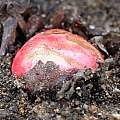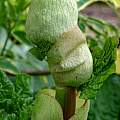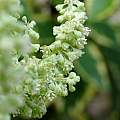Rheum L. is a genus in the Polygonaceae family containing about 60 species centered around the Himalayan region. It has a long history of medicinal (as a laxative), craft-related (as a dye) and culinary use, but the modern vegetable rhubarb was only bred and spread by the 18th century, when sugar became a cheap and ever-present commodity. Some species are grown as ornamentals for their often dramatic foliage effect.
Rheum species hibernate as a woody rhizome from which they quickly emerge in spring. A second dormancy in summer depends both on species and climate. All varieties contain oxalic acid, most prominently in the leaves, which may forward the formation of nephrolites in sensitive persons and has effects on calcium and iron metabolism.
The name rhubarb likely originates from the medieval Latin "rheu barbarum", meaning "foreign root", again stressing that the original usage was focused on the roots.
Hybrids
Rheum × hybridum is the common culinary garden rhubarb, as cultivated in cold to temperate climates around the world. It is a herbaceous perennial that grows from short, thick rhizomes. Its main ancestors are likely Rheum rhabarbarum L. and Rheum rhaponticum L., which hybridize easily. Rhubarb needs plenty of water when in growth and can deal with shade or sun, though sun encourages flowering which does use up a lot of the plants resources. Commercial plantings are said to be productive for about six years, after that the yields start to decline. In parts of the UK there is a tradition of forcing rhubarb in sheds or under clay pots, generating early, tender stalks.
Rhubarb cultivars include green and red stemmed varieties. In January 2020, rhubarb cultivars for warmer climates and/or cropping in summer and fall were a prominent topic on the PBS List. Photos were taken by Martin Bohnet.


